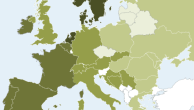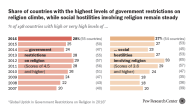Over the past century, the number of Catholics around the globe has more than tripled, from an estimated 291 million in 1910 to nearly 1.1 billion as of 2010, according to a comprehensive demographic study by the Pew Research Center.
But over the same period, the world’s overall population also has risen rapidly. As a result, Catholics have made up a remarkably stable share of all people on Earth. In 1910, Catholics comprised about half (48%) of all Christians and 17% of the world’s total population, according to historical estimates from the World Christian Database. A century later, the Pew Research study found, Catholics still comprise about half (50%) of Christians worldwide and 16% of the total global population.
What has changed substantially over the past century is the geographic distribution of the world’s Catholics. In 1910, Europe was home to about two-thirds of all Catholics, and nearly nine-in-ten lived either in Europe (65%) or Latin America (24%). By 2010, by contrast, only about a quarter of all Catholics (24%) were in Europe. The largest share (39%) were in Latin America and the Caribbean.
Rapid growth has occurred in sub-Saharan Africa, which today is home to about 171 million Catholics (16%), up from an estimated 1 million (less than 1%) in 1910. There also has been rapid growth in the vast Asia-Pacific region, where 131 million Catholics (12%) now live, up from 14 million (5%) a century ago.
North America’s share of the global Catholic population has increased more slowly, from about 15 million (5%) in 1910 to 89 million (8%) as of 2010.
Though the Middle East and North Africa are the ancient cradle of Christianity, the Middle East-North Africa region is home to less than 1% of Catholics today, about the same as in 1910.
How did the share of Catholics in various regions change between 1910 and 2010?
While there were dramatic shifts in the regional distribution of the Catholic population between 1910 and 2010, some of this change is due to different rates of overall population growth. Europe, for example, was home to 24% of the people in the world in 1910; as of 2010, just 11% of the world’s population lives in Europe. Meanwhile, Latin America and the Caribbean grew from 4% of the global population in 1910 to 9% in 2010.
Another way to look at the change between 1910 and 2010 is to compare the portion of each region’s population that is Catholic. Latin America was the most heavily Catholic region in both years, but the share of the region’s population that is Catholic decreased from about 90% in 1910 to 72% in 2010. Meanwhile, Europe’s population went from 44% Catholic to 35% Catholic. While both Latin America and Europe became less heavily Catholic over this period, Latin America – which had much larger population growth – eclipsed Europe to become the region with the largest Catholic population in sheer numbers.
As a percentage of regional population, the largest growth occurred in sub-Saharan Africa, which went from about 1% Catholic in 1910 to 21% Catholic in 2010. The Catholic share of the population in the Asia-Pacific region grew from 1% to 3% during this period. Meanwhile, the Catholic share of North America’s population grew from 16% to 26%.
How has the population changed in heavily Catholic countries in the past decade?
In several countries with large Catholic populations, the share of the populace identifying as Catholic has declined over the last decade. Brazil has the largest Catholic population in the world, but the share of self-identified Catholics in Brazil dropped from approximately three-quarters (74%) in 2000 to about two-thirds (65%) in 2010. Mexico, the country with the second-largest Catholic population in the world, went from about 89% Catholic in 2000 to 85% Catholic in 2010.
What do we know about the U.S. Catholic population?
The United States is home to about 7% of all Catholics in the world. As of 2010, an estimated 23% of U.S. adults and 24% of the total U.S. population (adults and children) are Catholic.
The Catholic population in the U.S. has undergone some striking demographic shifts despite hovering around a quarter of the population for several decades. For example, the Catholic population has lost more members than it has gained from religious switching. In fact, one-in-ten adults in the United States is a former Catholic, according to the Pew Research Center’s 2009 report “Faith in Flux.“
In addition, the Catholic population in the U.S. has been heavily shaped by immigration and includes a rising share of Latinos. More than half (52%) of all migrants to the United States are Catholic. Of the estimated 75.4 million Catholics in the United States in 2010, 22.2 million were born outside the United States (30%). By comparison, slightly more than 13% of the overall U.S. population is foreign-born.
Three-quarters (76%) of Catholic immigrants living in the U.S. are from Latin America and the Caribbean, while about 10% have come from Asia-Pacific and about 10% have come from Europe. In recent Pew Research Center surveys of adult Catholics, 60% are non-Hispanic whites, 33% are Hispanic and 7% are other minorities, including Asians.1
Which countries have the most Catholics now?
Which countries had the most Catholics in 1910?
Methodology
Data for 1910 come from the World Christian Database (Brill 2013) and are based on historical church membership data standardized by Todd M. Johnson and his colleagues at the Center for the Study of Global Christianity at Gordon-Conwell Theological Seminary in South Hamilton, Mass.
All the other demographic data in the report were compiled by the staff of the Pew Research Center and are based primarily on censuses and nationally representative surveys. European estimates were developed in collaboration with researchers at the International Institute for Applied Systems Analysis (IIASA) in Laxenburg, Austria.
This report updates 2010 Catholic population estimates published by the Pew Research Center in its 2011 report “Global Christianity: A Report on the Size and Distribution of the World’s Christian Population.” The updated 2010 Catholic population total (1,078,790,000) is slightly lower than the estimate published in the 2011 “Global Christianity” report (1,094,610,00). Some country estimates differ for two reasons. First, new data has become available, such as the 2010 census in Brazil. Second, estimates that relied on older data, such as the 2001 census in Austria, have been updated based on the population projections for the overall Christian population reported in the Pew Research Center’s 2012 report “The Global Religious Landscape: A Report on the Size and Distribution of the World’s Major Religious Groups as of 2010.” Detailed source lists and complete methodological discussions are included in the appendices of these Pew Research Center reports. The projections in the “Global Religious Landscape” report were made in collaboration with IIASA researchers. Migration estimates are drawn from the Pew Research Center’s Global Religion and Migration Database.
The Vatican Publishing House publishes a “Statistical Yearbook of the Church”, which includes Catholic population estimates. Pew Research’s census- and survey-based estimates for 2010 may vary from numbers reported in the “Statistical Yearbook.” For example, the “Statistical Yearbook” has a higher total Catholic population (1.196 billion) and higher estimates of the Catholic populations of Brazil (163,269,000) and Mexico (99,635,000). By contrast, Pew Research analysis of 2010 census data suggests there are 126,750,000 Catholics in Brazil and 96,450,000 Catholics in Mexico.
The Catholic Church includes the international body of churches in full communion with the bishop of Rome, the pope. These churches include the Western (or Latin) church and 22 Eastern Catholic churches. Each of these churches has a distinct hierarchy and traditional liturgy, prayers and religious observances. The Western (Latin) church is the largest of these churches. Among the major branches of the Eastern churches are the Alexandrian, Antiochene, Armenian, Byzantine and Chaldean.
Estimates for the number of Catholics in this report also include members of some relatively small Catholic groups (such as the Brazilian Catholic Apostolic Church) that are not in communion with the bishop of Rome.
Additional Resources on Catholicism
Pope Benedict Over the Years: News Coverage by the Numbers pewresearch.org – February 12, 2013
Resources on Catholicism and the Pope pewresearch.org/pewresearch-org/religion – December 11, 2011
Map: The world’s Catholics pewresearch.org/pewresearch-org/religion – December 19, 2011
Catholics’ Views of U.S. Bishops pewresearch.org/pewresearch-org/religion – November 12, 2012
Footnotes:
1 For more information about the racial and ethnic composition of U.S. religious groups, see the demographics section of the October 2012 report by the Pew Research Center’s Forum on Religion & Public Life, “‘Nones’ on the Rise.” (return to text)
Photo Credits: Getty Images




